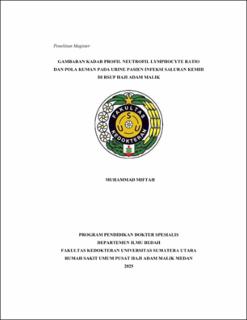Gambaran Kadar Profil Neutrofil Lymphocyte Ratio dan Pola Kuman pada Urine Pasien Infeksi Saluran Kemih di RSUP Haji Adam Malik
Neutrophil Lymphocyte Ratio and Urinary Bacterial Patterns in Patients with Urinary Tract Infection at RSUP Haji Adam Malik.

Date
2025Author
Miftah, Muhammad
Advisor(s)
Nasution, Ramlan
Kadar, Dhirajaya Dharma
Metadata
Show full item recordAbstract
Introduction: Urinary tract infection (UTI) is one of the most common infections
found in healthcare facilities and is a leading cause of nosocomial infections in
Indonesia. The Neutrophil-Lymphocyte Ratio (NLR) is a simple laboratory
indicator that can be used to assess inflammatory response and the severity of UTI.
However, local data on the association between NLR profiles and the bacterial
patterns causing UTI in Indonesia, particularly at RSUP Haji Adam Malik Medan,
remain limited.
Objective: This study aims to analyze the NLR profile and the distribution of
bacterial patterns in urine samples from UTI patients, as well as assess the
relationship between NLR levels and the bacterial patterns causing UTI at RSUP
Haji Adam Malik Medan.
Methods: This was an analytic observational study with a cross-sectional design,
involving 97 UTI patients hospitalized at RSUP Haji Adam Malik Medan during
April–May 2025. Data were collected through consecutive sampling and included
demographic characteristics, NLR values from laboratory tests, and urine culture
results for bacterial identification. The relationship between NLR profiles and
bacterial patterns was analyzed using chi-square or Fisher exact test, with
significance set at p<0.05.
Results: Most UTI patients had a normal NLR (68.0%), with 27.8% showing high
NLR and 4.1% low NLR. Escherichia coli was the most common isolated bacterium
(71.1%), followed by Klebsiella spp. (10.3%), Staphylococcus saprophyticus
(7.2%), Proteus spp. (4.1%), Enterococcus spp. (4.1%), and Pseudomonas
aeruginosa (3.1%). Statistical analysis showed no significant association between
NLR and the bacterial patterns causing UTI (p=0.08). However, there was a trend
of higher NLR being more frequently found in infections caused by Proteus and
Enterococcus.
Conclusion: The majority of UTI patients showed a normal NLR profile, with
Escherichia coli as the predominant pathogen. No significant relationship was
found between NLR levels and the bacterial pattern. This study highlights the need
for further research with larger samples and additional inflammatory biomarkers to
optimize the role of NLR in risk stratification and management of UTI.
